German Shepherd
The German Shepherd (German: Deutscher Schäferhund, German pronunciation: [ˈdɔʏtʃɐ ˈʃɛːfɐˌhʊnt]) is a breed of medium to large-sized working dog that originated in Germany. According to the FCI, the breed's English language name is German Shepherd Dog. The breed was officially[who?] known as the "Alsatian Wolf Dog" in the UK from after the First World War until 1977 when its name was changed back to German Shepherd.[2] Despite its wolf-like appearance, the German Shepherd is a relatively modern breed of dog, with its origin dating to 1899.
German Shepherd
.jpg)
Male German Shepherd
Other names
German Shepherd Dog
Alsatian wolf dog
Berger Allemand
Deutscher Schäferhund
Common nicknames
Alsatian DSH GSD Shepherd Schäferhund
Origin
Germany
Traits
Height
Dogs
60–65 cm (24–26 in)[1]
Bitches
55–60 cm (22–24 in)[1]
Weight
Dogs
30–40 kg (66–88 lb)[1]
Bitches
22–32 kg (49–71 lb)[1]
Coat
Double coat
Color
Tan with black saddle, sable, solid black or bi-color
Litter size
4–9
Life span
9–13
Kennel club standards
VDH
standard
FCI
standard
Dog (domestic dog)
As a herding dog, German Shepherds are working dogs developed originally for herding sheep. Since that time, however, because of their strength, intelligence, trainability, and obedience, German Shepherds around the world are often the preferred breed for many types of work, including disability assistance, search-and-rescue, police and military roles and acting.[3] The German Shepherd is the second-most registered breed by the American Kennel Club[4] and seventh-most registered breed by The Kennel Club in the United Kingdom.[5]
Description
German Shepherds are medium to large-sized dogs.[6] The breed standard height at the withers is 60–65 cm (24–26 in) for males, and 55–60 cm (22–24 in) for females.[7][8][9] German Shepherds are longer than they are tall, with an ideal proportion of 10 to 8 1⁄2. The AKC official breed standard does not set a standard weight range.[10] They have a domed forehead, a long square-cut muzzle with strong jaws and a black nose. The eyes are medium-sized and brown. The ears are large and stand erect, open at the front and parallel, but they often are pulled back during movement. A German Shepherd has a long neck, which is raised when excited and lowered when moving at a fast pace as well as stalking. The tail is bushy and reaches to the hock.[8]
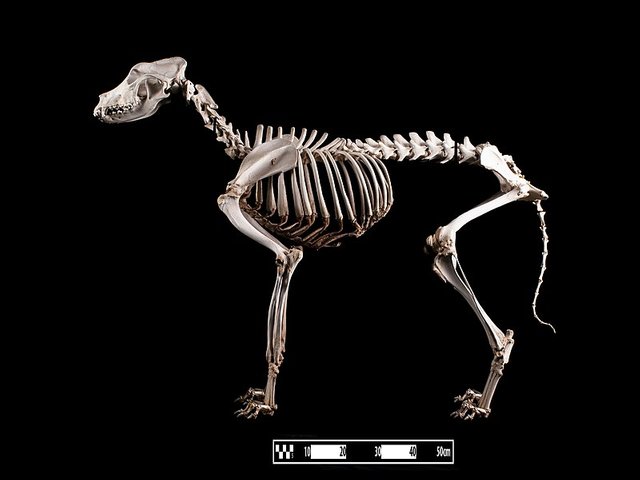
German Shepherd skeleton.
German Shepherds have a double coat which is close and dense with a thick undercoat. The coat is accepted in two variants: medium and long. The gene for long hair is recessive, and therefore the long-haired variety is rarer. Treatment of the long-haired variation differs across standards; it is accepted but does not compete against standard-coated dogs under the German and UK Kennel Clubs while it can compete with standard-coated dogs, but is considered a fault, in the American Kennel Club.[8][10][11] The FCI accepted the long-haired type in 2010, listing it as the variety b, while the short-haired type is listed as the variety a.[12]
Most commonly, German Shepherds are either tan/black or red/black. Most color varieties have black masks and black body markings which can range from a classic "saddle" to an overall "blanket". Rarer color variations include the sable, pure-black, pure-white, liver, silver, blue, and panda varieties. The all-black and sable varieties are acceptable according to most standards; however, the blue and liver are considered to be serious faults and the all-white is grounds for instant disqualification from showing in conformation at All Breed and Specialty Shows.[10]
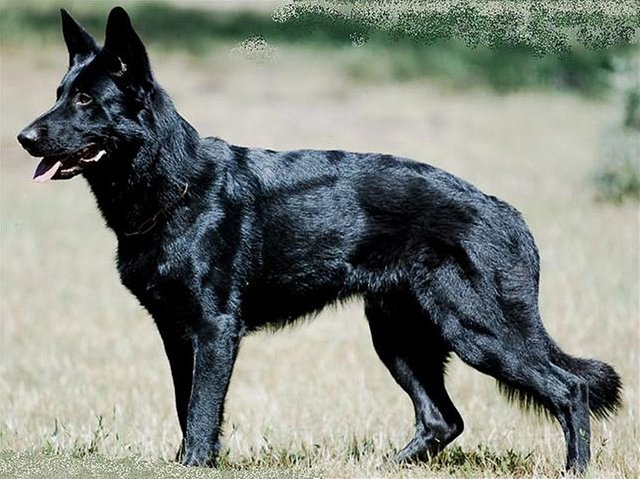
Male German Shepherd dog with a saddle black-and-tan coat
German Shepherd dog with black mask and sable coat
Solid black German Shepherd dog
Bi-color military working German Shepherd dog
A male German Shepherd showing the long muzzle, black mask and nose and brown, medium-sized eyes
A black and tan long-haired German Shepherd
Black German Shepherd male ca. 6 months old
Intelligence
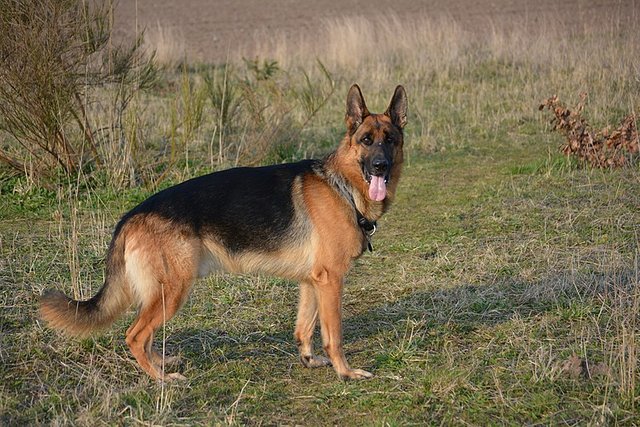
German Shepherds were bred specifically for their intelligence.[13] In a list of breeds most likely to bark as watchdogs, Stanley Coren ranked the breed in second place.[3] Coupled with their strength, this trait makes the breed desirable as police, guard and search and rescue dogs, as they are able to quickly learn various tasks and interpret instructions better than other breeds.[14]
Temperament
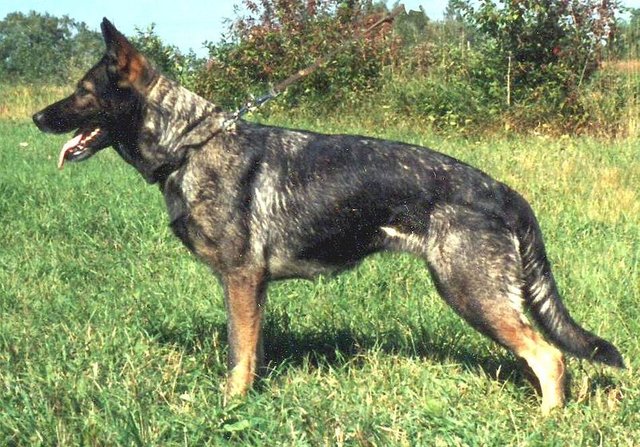
German Shepherds are well-known for their protectiveness over family members
German Shepherds are moderately active dogs and are described in breed standards as self assured.[10] The breed is marked by a willingness to learn and an eagerness to have a purpose. They are curious, which makes them excellent guard dogs and suitable for search missions. They can become overprotective of their family and territory, especially if not socialized correctly.[15] They are not inclined to become immediate friends with strangers.[16] German Shepherds are highly intelligent and obedient, as well as protective of their owners.[17]
Aggression and biting
.2.jpg)
Further information: Dog bite prevention
While an Australian report from 1999 provides statistics showing that German Shepherds are the breed third most likely to attack a person in some Australian locales,[18] once their popularity is taken into account, the percentages of GSD attacks drops to 38th.[19]
According to the National Geographic Channel television show Dangerous Encounters, the bite of a German Shepherd has a force of over 1,060 newtons (238 lbf) (compared with that of a Rottweiler, over 1,180–1,460 newtons (265–328 lbf), a Pit bull, 1,050 newtons (235 lbf), a Labrador Retriever, of approximately 1,000 newtons (230 lbf), or a human, of approximately 380 newtons (86 lbf)).[20]
Modern breed
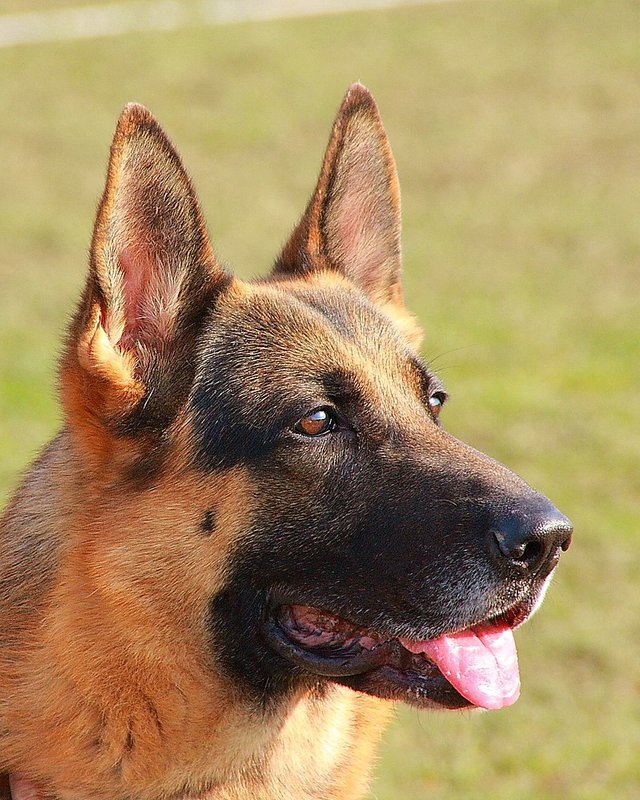
The typical kennel club's breeding goal for modern structure of the body of GSD
The modern German Shepherd breed is criticized by some for straying away from Max von Stephanitz's original ideology that German Shepherds should be bred primarily as working dogs and that breeding should be strictly controlled to eliminate defects quickly.[21][22] He believed that, above all else, German Shepherds should be bred for intelligence and working ability.[23]

Controversy
The Kennel Club, in the United Kingdom, is involved in a dispute with German Shepherd breed clubs about the issue of soundness in the show strain of the breed.[24][25] Some show strains have been bred with an extremely roached topline (back) that causes poor gait in the hind legs.
The debate was catalyzed when the issue was raised in the BBC documentary, Pedigree Dogs Exposed, which said that critics of the breed describe it as "half dog, half frog." An orthopedic vet remarked on footage of dogs in a show ring that they were "not normal."
The Kennel Club's position is that "this issue of soundness is not a simple difference of opinion, it is the fundamental issue of the breed's essential conformation and movement."[24] The Kennel Club has decided to retrain judges to penalize dogs suffering these problems.[26]
The Kennel Club also recommends testing for haemophilia and hip dysplasia, other common problems with the breed.[27][28]
A special, intelligent, brave and fierce breed of dog.